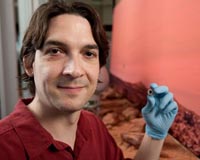 |
College of Engineering Tucson AZ (SPX) May 03, 2010 The projects are among 60 by UA engineering students to be showcased at Engineering Design Day, the UA College of Engineering's premier showcase of student design. A revolutionary new camera for the Mars Lander and a flying blanket that wraps you up and pins you down are two of the many student engineering projects on display May 4. The projects are among 60 by UA engineering students to be showcased at Engineering Design Day, the UA College of Engineering's premier showcase of student design. Design Day is organized by the College's Interdisciplinary Design Program, Engineering 498, and co-sponsored by Lockheed Martin and BAE Systems as well as the college. "Engineering 498 is our dry run for students," said Jeff Goldberg, the college's dean. "We give students the real-life experience of doing a project for an external client. The course is really a simulation of that first project." The event is open to the public, and Goldberg is especially keen to attract middle and high school students to give them a better picture of what engineering is. "It is by far our best advertisement for what engineers do once they get out of college," Goldberg said. Goldberg said Design Day judges have seen similar events at dozens of other universities, and the feedback from them is that UA's event is by far the strongest. "What makes our Design Day stronger than so many others are our great industry clients, our instructors, and a lot of really good students who enjoy building a prototype and solving the design problems," Goldberg said. Seniors in the UA College of Engineering will compete for about $10,000 in prize money during the competition, which is held annually. The students have been working on their projects for two semesters. Presentations will take place from 10 a.m. to 3 p.m. on May 4 in the Student Recreation Center, 1400 E. 6th St. The UA student projects cover a wide range of engineering disciplines related to space exploration and imaging, homeland security, healthcare, renewable energy, robotics and more. Event judges are practicing engineers from companies throughout the country and will review the design presentations and demonstrations. The judges will then compile a list of finalists to be reviewed a second time during the afternoon. The award ceremony will be held at 4 p.m. Completing a senior capstone project as a team is a graduation requirement for most UA engineering students, and the showcase is a chance to present the college's expertise in areas such as biomechanics and sustainable energy. The senior capstone program gives students experience working on real-world design projects that involve budgets, reviews and deadlines. Many of the projects go on to yield patented commercial products. The projects are sponsored and funded by student clubs, faculty members and industry partners such as Lockheed Martin, Ventana Medical Systems, BAE Systems, Raytheon, Texas Instruments, Edmund Optics and Honeywell. The companies also sponsor prizes and provide some of the approximately 70 professional engineers who serve as judges.
Flying Blanket
Space Suit Air Systems Switching Valve Paragon is developing a new technology to remove carbon dioxide from space suit life support systems, and the company has asked students to design a valve that helps collect and vent carbon dioxide. The finished system will improve energy efficiency, reduce water usage, and reduce environmental contamination in Paragon's Orion spacesuit.
Global Warming in Arizona Based on a 60-Day Test
Remote Pulse Oximeter
NASA RISA Camera Project for Mars Lander The specifications require the final design to have wireless power and communications, and to be small, light, and energy efficient. It will also have to be very tough. Current space cameras are considered virtually disposable because the radiation and temperature extremes found in space wreak havoc with instrumentation.
Share This Article With Planet Earth
Related Links University of Arizona Mars News and Information at MarsDaily.com Lunar Dreams and more
 Clues About Mars Evolution Revealed
Clues About Mars Evolution RevealedHouston TX (SPX) Apr 19, 2010 Through the study of a popular Martian meteorite's age, a University of Houston professor and his team have made significant discoveries about the timeline of volcanic activity on Mars. Thomas Lapen, assistant professor of geosciences at UH, describes his team's findings in a paper titled "A Younger Age for ALH84001 and its Geochemical Link to Shergottite Sources in Mars," appeared April 1 ... read more |
|
| The content herein, unless otherwise known to be public domain, are Copyright 1995-2010 - SpaceDaily. AFP and UPI Wire Stories are copyright Agence France-Presse and United Press International. ESA Portal Reports are copyright European Space Agency. All NASA sourced material is public domain. Additional copyrights may apply in whole or part to other bona fide parties. Advertising does not imply endorsement,agreement or approval of any opinions, statements or information provided by SpaceDaily on any Web page published or hosted by SpaceDaily. Privacy Statement |